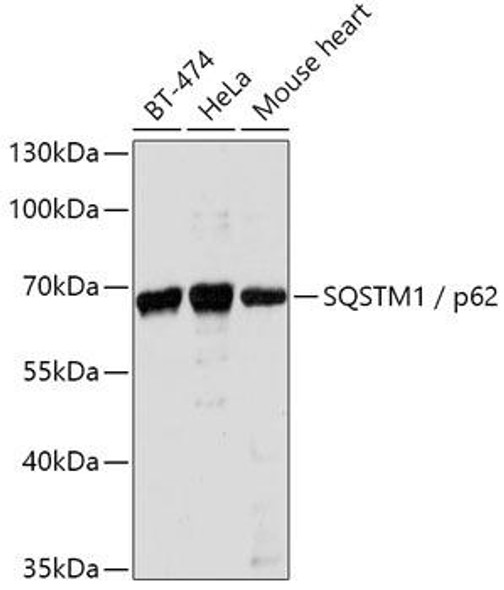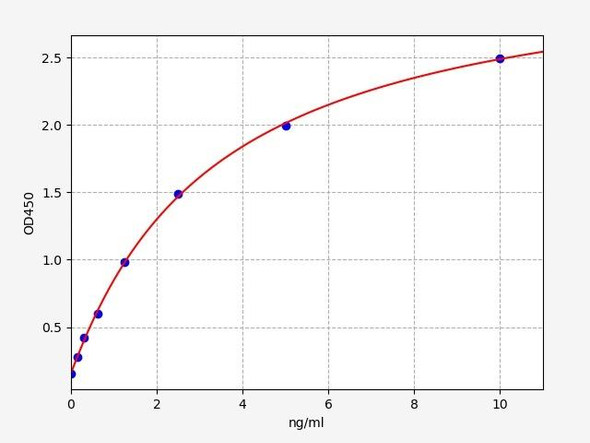Human P62/SQSTM1(Sequestosome-1) ELISA Kit
- SKU:
- HUFI03323
- Product Type:
- ELISA Kit
- Size:
- 96 Assays
- Uniprot:
- Q13501
- Sensitivity:
- 0.094ng/ml
- Range:
- 0.156-10ng/ml
- ELISA Type:
- Sandwich ELISA, Double Antibody
- Synonyms:
- A170, EBIAP, ORCA, OSIL, p60, P62, P62
- Reactivity:
- Human
Description
| Product Name: | Human P62/SQSTM1(Sequestosome-1) ELISA Kit |
| Product Code: | HUFI03323 |
| Size: | 96 Assays |
| Alias: | A170, EBIAP, ORCA, OSIL, p60, P62, P62;SQSTM1, p62B, PDB3, sequestosome 1, SQSTM1, Ubiquitin binding protein p62, ZIP3 |
| Detection method: | Sandwich ELISA, Double Antibody |
| Application: | This immunoassay kit allows for the in vitro quantitative determination of Human P62/SQSTM1 concentrations in serum plasma and other biological fluids. |
| Sensitivity: | 0.094ng/ml |
| Range: | 0.156-10ng/ml |
| Storage: | 4°C for 6 months |
| Note: | For Research Use Only |
| Recovery: | Matrices listed below were spiked with certain level of Human P62/SQSTM1 and the recovery rates were calculated by comparing the measured value to the expected amount of Human P62/SQSTM1 in samples. Enquire for more information. |
| Linearity: | The linearity of the kit was assayed by testing samples spiked with appropriate concentration of Human P62/SQSTM1 and their serial dilutions. The results were demonstrated by the percentage of calculated concentration to the expected. Enquire for more information. |
| CV(%): | Intra-Assay: CV<8% Inter-Assay: CV<10% |
| Component | Quantity | Storage |
| ELISA Microplate (Dismountable) | 8×12 strips | 4°C for 6 months |
| Lyophilized Standard | 2 | 4°C/-20°C |
| Sample/Standard Dilution Buffer | 20ml | 4°C |
| Biotin-labeled Antibody(Concentrated) | 120ul | 4°C (Protect from light) |
| Antibody Dilution Buffer | 10ml | 4°C |
| HRP-Streptavidin Conjugate(SABC) | 120ul | 4°C (Protect from light) |
| SABC Dilution Buffer | 10ml | 4°C |
| TMB Substrate | 10ml | 4°C (Protect from light) |
| Stop Solution | 10ml | 4°C |
| Wash Buffer(25X) | 30ml | 4°C |
| Plate Sealer | 5 | - |
Other materials and equipment required:
- Microplate reader with 450 nm wavelength filter
- Multichannel Pipette, Pipette, microcentrifuge tubes and disposable pipette tips
- Incubator
- Deionized or distilled water
- Absorbent paper
- Buffer resevoir
| Uniprot | Q13501 |
| UniProt Protein Function: | SQSTM1: an adapter protein which binds ubiquitin, shuttling proteins to the proteasome. Co-localizes along with the E3 ubiquitin ligase, TRAF6, to aggregates from Alzheimer's disease brains but not in control brain. May regulate the activation of NFKB1 by TNF-alpha, nerve growth factor (NGF) and interleukin-1. May play a role in titin downstream signaling in muscle cells. May regulate signaling cascades through ubiquitination. May be involved in cell differentiation, apoptosis, immune response and regulation of K(+) channels. Forms ternary complexes with PKCZ and Kv-beta2 or PKCZ and GABBR3. Also interacts with KCNAB1, GABRR1, GABRR2 and GABRR3. Interacts with EBI3, LCK, RASA1, PKCZ , PKCI, NR2F2, NTRK1, NTRK2, NTRK3, NBR1, MEK5, TRIM55 and MAPKAPK5. Interacts with the proteasome subunits PSMD4 and PSMC2. Interacts with K63- polyubiquitinated MAPT/TAU. Interacts with IKBKB through PRKCZ and PRKCI. Interacts with NGFR through TRAF6 and bridges that complex to NTRK1. Forms a complex with MEK5 and PRKCZ or PRKCI. Component of a ternary complex with PAWR and PRKCZ. Upon TNF-alpha stimulation, interacts with RIPK1 problably bridging IKBKB to the TNF-R1 complex composed of TNF-R1/TNFRSF1A, TRADD and RIPK1. Forms a complex with JUB/Ajuba, PRKCZ and TRAF6. 2 isoforms of the human protein are produced by alternative splicing. |
| UniProt Protein Details: | Protein type:Nuclear receptor co-regulator; Autophagy; Ubiquitin conjugating system Chromosomal Location of Human Ortholog: 5q35 Cellular Component: nucleoplasm; PML body; endoplasmic reticulum; lysosome; cytoplasm; late endosome; autophagic vacuole; cytoplasmic vesicle; inclusion body; cytosol Molecular Function:identical protein binding; protein serine/threonine kinase activity; protein binding; ubiquitin binding; protein homodimerization activity; protein kinase C binding; zinc ion binding; SH2 domain binding; receptor tyrosine kinase binding; protein kinase binding Biological Process: regulation of Ras protein signal transduction; ubiquitin-dependent protein catabolic process; nerve growth factor receptor signaling pathway; immune system process; positive regulation of apoptosis; protein heterooligomerization; macroautophagy; endosome transport; protein amino acid phosphorylation; protein localization; response to stress; autophagy; positive regulation of transcription from RNA polymerase II promoter; positive regulation of protein amino acid phosphorylation; cell differentiation; regulation of I-kappaB kinase/NF-kappaB cascade; positive regulation of macroautophagy; negative regulation of apoptosis Disease: Frontotemporal Dementia And/or Amyotrophic Lateral Sclerosis 3; Paget Disease Of Bone |
| NCBI Summary: | This gene encodes a multifunctional protein that binds ubiquitin and regulates activation of the nuclear factor kappa-B (NF-kB) signaling pathway. The protein functions as a scaffolding/adaptor protein in concert with TNF receptor-associated factor 6 to mediate activation of NF-kB in response to upstream signals. Alternatively spliced transcript variants encoding either the same or different isoforms have been identified for this gene. Mutations in this gene result in sporadic and familial Paget disease of bone. [provided by RefSeq, Mar 2009] |
| UniProt Code: | Q13501 |
| NCBI GenInfo Identifier: | 74735628 |
| NCBI Gene ID: | 8878 |
| NCBI Accession: | Q13501.1 |
| UniProt Related Accession: | Q13501 |
| Molecular Weight: | |
| NCBI Full Name: | Sequestosome-1 |
| NCBI Synonym Full Names: | sequestosome 1 |
| NCBI Official Symbol: | SQSTM1Â Â |
| NCBI Official Synonym Symbols: | p60; p62; A170; DMRV; OSIL; PDB3; ZIP3; p62B; NADGP; FTDALS3Â Â |
| NCBI Protein Information: | sequestosome-1 |
| UniProt Protein Name: | Sequestosome-1 |
| UniProt Synonym Protein Names: | EBI3-associated protein of 60 kDa; EBIAP; p60; Phosphotyrosine-independent ligand for the Lck SH2 domain of 62 kDa; Ubiquitin-binding protein p62 |
| UniProt Gene Name: | SQSTM1Â Â |
| UniProt Entry Name: | SQSTM_HUMAN |
*Note: Protocols are specific to each batch/lot. For the correct instructions please follow the protocol included in your kit.
Before adding to wells, equilibrate the SABC working solution and TMB substrate for at least 30 min at 37°C. When diluting samples and reagents, they must be mixed completely and evenly. It is recommended to plot a standard curve for each test.
| Step | Protocol |
| 1. | Set standard, test sample and control (zero) wells on the pre-coated plate respectively, and then, record their positions. It is recommended to measure each standard and sample in duplicate. Wash plate 2 times before adding standard, sample and control (zero) wells! |
| 2. | Aliquot 0.1ml standard solutions into the standard wells. |
| 3. | Add 0.1 ml of Sample / Standard dilution buffer into the control (zero) well. |
| 4. | Add 0.1 ml of properly diluted sample ( Human serum, plasma, tissue homogenates and other biological fluids.) into test sample wells. |
| 5. | Seal the plate with a cover and incubate at 37 °C for 90 min. |
| 6. | Remove the cover and discard the plate content, clap the plate on the absorbent filter papers or other absorbent material. Do NOT let the wells completely dry at any time. Wash plate X2. |
| 7. | Add 0.1 ml of Biotin- detection antibody working solution into the above wells (standard, test sample & zero wells). Add the solution at the bottom of each well without touching the side wall. |
| 8. | Seal the plate with a cover and incubate at 37°C for 60 min. |
| 9. | Remove the cover, and wash plate 3 times with Wash buffer. Let wash buffer rest in wells for 1 min between each wash. |
| 10. | Add 0.1 ml of SABC working solution into each well, cover the plate and incubate at 37°C for 30 min. |
| 11. | Remove the cover and wash plate 5 times with Wash buffer, and each time let the wash buffer stay in the wells for 1-2 min. |
| 12. | Add 90 µl of TMB substrate into each well, cover the plate and incubate at 37°C in dark within 10-20 min. (Note: This incubation time is for reference use only, the optimal time should be determined by end user.) And the shades of blue can be seen in the first 3-4 wells (with most concentrated standard solutions), the other wells show no obvious color. |
| 13. | Add 50 µl of Stop solution into each well and mix thoroughly. The color changes into yellow immediately. |
| 14. | Read the O.D. absorbance at 450 nm in a microplate reader immediately after adding the stop solution. |
When carrying out an ELISA assay it is important to prepare your samples in order to achieve the best possible results. Below we have a list of procedures for the preparation of samples for different sample types.
| Sample Type | Protocol |
| Serum | If using serum separator tubes, allow samples to clot for 30 minutes at room temperature. Centrifuge for 10 minutes at 1,000x g. Collect the serum fraction and assay promptly or aliquot and store the samples at -80°C. Avoid multiple freeze-thaw cycles. If serum separator tubes are not being used, allow samples to clot overnight at 2-8°C. Centrifuge for 10 minutes at 1,000x g. Remove serum and assay promptly or aliquot and store the samples at -80°C. Avoid multiple freeze-thaw cycles. |
| Plasma | Collect plasma using EDTA or heparin as an anticoagulant. Centrifuge samples at 4°C for 15 mins at 1000 × g within 30 mins of collection. Collect the plasma fraction and assay promptly or aliquot and store the samples at -80°C. Avoid multiple freeze-thaw cycles. Note: Over haemolysed samples are not suitable for use with this kit. |
| Urine & Cerebrospinal Fluid | Collect the urine (mid-stream) in a sterile container, centrifuge for 20 mins at 2000-3000 rpm. Remove supernatant and assay immediately. If any precipitation is detected, repeat the centrifugation step. A similar protocol can be used for cerebrospinal fluid. |
| Cell culture supernatant | Collect the cell culture media by pipette, followed by centrifugation at 4°C for 20 mins at 1500 rpm. Collect the clear supernatant and assay immediately. |
| Cell lysates | Solubilize cells in lysis buffer and allow to sit on ice for 30 minutes. Centrifuge tubes at 14,000 x g for 5 minutes to remove insoluble material. Aliquot the supernatant into a new tube and discard the remaining whole cell extract. Quantify total protein concentration using a total protein assay. Assay immediately or aliquot and store at ≤ -20 °C. |
| Tissue homogenates | The preparation of tissue homogenates will vary depending upon tissue type. Rinse tissue with 1X PBS to remove excess blood & homogenize in 20ml of 1X PBS (including protease inhibitors) and store overnight at ≤ -20°C. Two freeze-thaw cycles are required to break the cell membranes. To further disrupt the cell membranes you can sonicate the samples. Centrifuge homogenates for 5 mins at 5000xg. Remove the supernatant and assay immediately or aliquot and store at -20°C or -80°C. |
| Tissue lysates | Rinse tissue with PBS, cut into 1-2 mm pieces, and homogenize with a tissue homogenizer in PBS. Add an equal volume of RIPA buffer containing protease inhibitors and lyse tissues at room temperature for 30 minutes with gentle agitation. Centrifuge to remove debris. Quantify total protein concentration using a total protein assay. Assay immediately or aliquot and store at ≤ -20 °C. |
| Breast Milk | Collect milk samples and centrifuge at 10,000 x g for 60 min at 4°C. Aliquot the supernatant and assay. For long term use, store samples at -80°C. Minimize freeze/thaw cycles. |






![Anti-SQSTM1 / p62 Antibody [KO Validated] (CAB19700) Anti-SQSTM1 / p62 Antibody [KO Validated] (CAB19700)](https://cdn11.bigcommerce.com/s-39x6lpnvxv/images/stencil/590x590/products/30809/28998/anti-sqstm1-p62-antibody-ko-validated-cab19700__20324__35692.1644317155.jpg?c=1)
![Anti-SQSTM1 / p62 Antibody (CAB11483)[KO Validated] Anti-SQSTM1 / p62 Antibody (CAB11483)[KO Validated]](https://cdn11.bigcommerce.com/s-39x6lpnvxv/images/stencil/590x590/products/19366/17566/anti-sqstm1-p62-antibody-cab11483ko-validated__87291__04017.1644251960.jpg?c=1)


